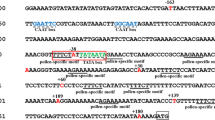Abstract
Five different copy DNA clones coding for the same leghemoglobin were isolated from a winged-bean (Psophocarpus tetragonolobus L.) nodule library. Although identical in sequence, they each possess a different side of polyadenylation located 93–128 nucleotides downstream of two overlapping AAUAAA putative signal sequences. By analysis of the untranslated 3′ ends, a potential mRNA secondary structure can be predicted which could explain the observed polyadenylation heterogeneity. The structure is a size-variable hairpin, creating a net topological distance of 25–27 nucleotides between the canonical signal sequence and the different polyadenylation sites observed. We suggest that this type of variable secondary structure could be one among other causes that determines the apparent flexibility of plant polyadenylation. It could also confer particular properties to the mRNA in relation to stability, translation efficiency and-or nuclear export.
Similar content being viewed by others
Abbreviations
- cDNA:
-
copy DNA
References
Ahmed, Y., Gilmartin, G.M., Hanly, S.M., Nevins, J.R., Greene, W.C. (1991) The HTLV-I rex response element mediates a novel form of mRNA polyadenylation. Cell 64, 727–737
Barker, D.G., Gallusci, P., Lullien, V., Khan, H., Ghérardi, M., Huget, T. (1988) Identification ot two groups of leghemoglobin genes in alfalfa (Medicago sativa) and a study of their expression during root nodule development. Plant Mol. Biol. 11, 761–772
Dean, C., Tamaki, S., Dunsmuir, P., Favreau, M., Katamaya, C., Dooner, H., Bedbrook, J. (1986) mRNA transcripts of several plant genes are polyadenylated at multiple sites in vivo. Nucleic Acids Res. 14, 2229–2240
Hunt, A.G., MacDonald, M.H. (1989) Deletion analysis of the polyadenylation signal of the pea ribulose-1,5-bisphosphate carboxylase small-subunit gene. Plant Mol. Biol. 13, 125–138
Hunt, A.G., Chu, N.M., Odell, J.T., Nagy, F., Chua, N.H. (1987) Plant cells do not properly recognize animal gene polyadenylation signals Plant Mol. Biol. 8, 23–35
Ingelbrecht, I.L.W., Herman, L.M.F., Dekeyser, R.A., Van Montagu, M.C., Depicker, A.G. (1989) Different 3′end regions strongly influence the level of expression in plant cells. Plant Cell 1, 671–680
Joshi, C.P. (1987) Putative polyadenylation signals in nuclear genes of higher plants: a compilation and analysis. Nucleic Acids Res. 15, 9627–9640
Kuhse, J., Pühler, A. (1987) Conserved sequence motifs in the untranslated 3′end of leghemoglobin transcripts isolated from broadbean nodules. Plant Sci. 49, 137–143
LeMeur, M.A., Galliot, B., Gerlinger, P. (1984) Termination of the ovalbumin gene transciption. EMBO J. 3, 2279–2286
Malim, M.H., Hauber, J., Le, S.-Y., Maizel, J.V., Cullen, B.R. (1989) The Hiv-1 rev trans-activator acts through a structured target sequence to activate nuclear export of unspliced viral mRNA. Nature 338, 254–257
Manen, J.-F., Simon, P., Van Slooten, J.-C., Osteras, M., Frutiger, S., Hughes, G.J. (1991) A nodulin expressed in senescent nodules of winged bean is a protease inhibitor. Plant Cell 3, 259–270
Mogen, B.D. MacDonald, M.H. Graybosch, R. Hunt, A.G. (1990) Upstream sequence other than AAUAAA are required for efficient messenger RNA 3′end formation in plants. Plant Cell 2, 1261–1272
Sanchez, F., Padilla, J.E., Pérez, H., Lara, M. (1991) Control of nodulin genes in root-nodule development and metabolism. Annu. Rev. Plant Physiol. 42, 507–528
Sanfaçon, H., Brodman, P., Hohn, T. (1991) A dissection of the cauliflowwer mosaic virus polyadenylation signal. Genes Develop. 5, 141–149
Sasavage, N.L., Smith, M., Gillam, S., Woychick, R.P., Rottman, F.M. (1982) Variation in the polyadenylation site of bovine prolactin mRNA. Proc. Natl. Acad. Sci. USA 79, 223–227
Wiborg, O., Hylding-Nielsen, J.J., Jensen, E.O., Paludan, K., Marcker, K.A. (1982) The nucleotide sequence of two leghemoglobin genes from soybean. Nucleic Acids Res. 10, 3487–3495
Wickens, M. (1990) How the messenger got its tail: addition of poly(A) in the nucleus. TIBS 15, 277–281
Zuker, M., Stiegler, P. (1981) Optimal computer folding of large RNA sequences using thermodynamic and auxiliary information. Nucleic Acids Res. 9, 133–148
Author information
Authors and Affiliations
Additional information
This work was supported by the Fonds National Suisse de la Recherche Scientifique (Contracts Nos 3.176-0.85 and 31-28757.90).
Rights and permissions
About this article
Cite this article
Manen, JF., Simon, P. A possible explanation for the multiple polyadenylation sites in transcripts coding for a winged-bean leghemoglobin. Planta 191, 289–292 (1993). https://doi.org/10.1007/BF00199763
Received:
Accepted:
Issue Date:
DOI: https://doi.org/10.1007/BF00199763




